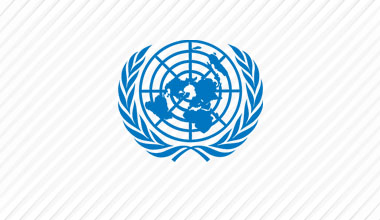“Mr. and Mrs. Blue Barrel” educate young children on Blue Line safety
First Sergeant Etikasari, a UNIFIL Indonesian peacekeeper, is visiting the public school in Aytarun, a village close to the Blue Line in south Lebanon. She stands at the front of the class and begins a discussion with the ten-year olds. She is animated and fun, and the children respond to her bright smile. They raise their hands to participate in the discussion about UNIFIL and the Blue Line.
In front of the class are some props: two blue barrels with painted faces and a four-metre blue rope tied between the barrels. The pupils jump up to volunteer to show the rest of the class the dangers of crossing the Blue Line. As they step over the blue rope Sgt Etikasari asks the rest of the class ‘should they have crossed? And their class mates yell, “NO!”
These young people have got the message. Approaching the real Blue Line can be extremely dangerous. There is a high risk of encountering mines, unexploded ordinances and explosive remnants of war. Approaching the blue barrels also risks accidental crossing, which is a violation of the UN Security Council resolution 1701.
Sgt Etikasari explains how they had to make the presentation interactive to make it memorable, “We were thinking how to make this explanation about UNIFIL and the Blue Line not boring for these young people. We wanted to hold their attention, so we made the Mr. and Mrs. Blue Barrel to make it compelling for the students.”
Sgt Etikasari and her colleagues are from UNIFIL's military community outreach unit (MCOU). They visit schools along the Blue Line to help educate a generation on safety and the importance of not crossing the line, which can unnecessarily escalate tension along the demarcation line that is being patrolled by UNIFIL in collaboration with the Lebanese Armed Forces.
The education sessions touch on some of the core aspects of UNIFIL’s mandate - from ensuring the stability in its area of operations, especially along the Blue Line, and the Protection of Civilians.
Arwa, a young student from Yarin Public School, says after the briefing, “I learned that if we see a landmine we should not approach it, we have to be very careful. And when we see a Blue Barrel we should not go beyond it.”
After hearing the presentation, Ms. Tharwat George Hassrouni, one of the teachers in Yarin Public School, explains why this outreach work from UNIFIL is crucial for the children’s personal safety, “Today’s lecture was very important, especially as the children live in an area close to the Blue Line. They visit the area frequently to plant vegetables, play, and visit the woods. So it is important they learn to be careful and never to approach the contaminated lands.”
BACKGROUND TO THE "BLUE LINE":
The 120-kilometre Line of Withdrawal, or “Blue line” as it is more commonly known, was established by the United Nations in the year 2000 to confirm the withdrawal of Israeli forces from Lebanon. At a tripartite meeting in 2007, both parties agreed to visibly mark the Blue Line on the ground.
It is important to note: The Blue Line does not in any way represent an international border and is without prejudice to any future border agreements between Lebanon and Israel. The Blue Line marking process is an ongoing tripartite project to foster mutual trust and to diffuse tensions. Blue barrels also directly contribute to the security of the people living on both sides of the Blue Line by preventing inadvertent crossing.
--------------------------------------------------------------------------------------------------
Article: Aoibheann O'Sullivan
Video camera: Mohamad Hamze, Aoibheann O'Sullivan
Video Editor: Suzane Badereddine, Aoibheann O'Sullivan
Motion Graphics: Zeina Ezzeddine
Photo: Pascual Gorriz
--------------------------------------------------------------------------------------------------
 UN
UN United Nations Peacekeeping
United Nations Peacekeeping








